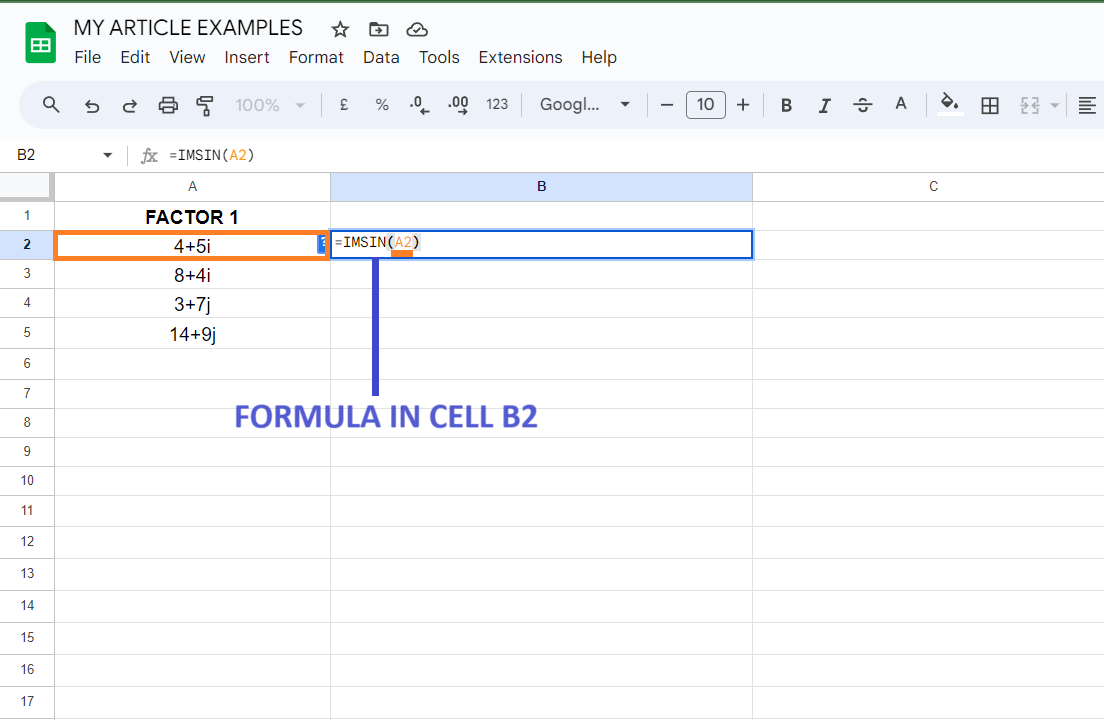Table of Contents
Introduction
The IMSINH function is a powerful tool in Google Sheets that helps us work with complex numbers. It specifically calculates the hyperbolic sine of a complex number. Now, don’t let the term “complex number” intimidate you! In simple terms, it’s a combination of a real part (like x) and an imaginary part (like yi). In this article, we’ll guide you on how to use the IMSINH function step by step, making it easy for even 5th-grade students to understand.
When to Use IMSINH Function
The IMSINH function is particularly handy when dealing with situations that involve complex numbers. It helps in finding the hyperbolic sine of these numbers, which can be useful in various mathematical and engineering applications.
How to use IMSINH function in Google Sheets
Type “=IMSINH ” or go to the “Insert” tab ➝ “Function” ➝ “Engineering” ➝ “IMSINH”.

Syntax
IMSINH (number)
number – The complex number for which you want the hyperbolic sine.
Example:
Step 1: Open Your Google Sheet

Step 2: Select a Cell and Enter the Function

Step 3: Press Enter: Hit the Enter key to apply the function

Tips for Optimization
Certainly! Here are some tips for optimising the use of the IMSINH function in Google Sheets:
- Double-Check Syntax:
- Ensure that you’ve entered the function with the correct spelling and syntax, including the opening and closing parentheses.
- Use Parentheses for Complex Numbers:
- Always enclose complex numbers in parentheses to prevent errors. For instance, use (2 + 3i) instead of 2 + 3i.
- Verify Complex Number Input:
- Double-check that you’ve entered the correct real and imaginary parts for the complex number.
- Avoid Mixing Formats:
- Stick to a consistent format for complex numbers. Mixing formats can lead to unexpected results.
- Understand Trigonometric Functions:
- Familiarise yourself with hyperbolic functions like sinh and cosh, as they are commonly used in complex number calculations.
- Use IMSINH in Relevant Contexts:
- Apply IMSINH in situations that involve complex numbers and require the calculation of hyperbolic sine.
- Test with Simple Cases:
- Start with straightforward examples to ensure you’re getting the expected results before applying the function to more complex scenarios.
- Keep an Eye on Units:
- If you’re working with units, make sure they’re consistent across your calculations to avoid errors.
- Utilize Error Handling:
- Implement error-handling techniques like IFERROR to gracefully manage cases where the IMSINH function might encounter issues.
- Document Your Work:
- Add comments or annotations in your spreadsheet to explain the purpose of IMSINH functions, which can be helpful for yourself or others who may review the sheet.
Real-World Application
Certainly! Here are some real-world applications of the IMSINH function in Google Sheets, explained in points:
- Electrical Engineering:
- IMSINH is used in analyzing alternating current (AC) circuits. It appears in solutions to differential equations that describe circuits with resistors, inductors, and capacitors.
- Control Systems:
- In control theory, IMSINH can be used to model and analyze systems that exhibit exponential growth or decay, which is common in processes like chemical reactions or population growth.
- Telecommunications:
- IMSINH can find applications in signal processing and modulation techniques. It helps in understanding and manipulating complex waveforms used in telecommunications systems.
- Quantum Mechanics:
- Complex numbers are fundamental in quantum mechanics. IMSINH can be applied in various quantum mechanical calculations, especially in contexts involving wave functions and probability amplitudes.
- Fluid Dynamics:
- In fluid dynamics, particularly in the study of compressible flows, complex numbers are used to represent wave phenomena. IMSINH may be used in these calculations.
- Financial Modeling:
- Complex numbers can be used in financial models, especially in scenarios involving compound interest and exponential growth. IMSINH can aid in these calculations.
- Wireless Communication:
- In wireless communication systems, complex numbers are used to represent the phase and amplitude of signals. IMSINH can play a role in various signal processing operations.
- Medical Imaging:
- Complex numbers are used extensively in medical imaging techniques like MRI and CT scans. IMSINH might be employed in the analysis and reconstruction of image data.
- Astronomy and Astrophysics:
- Complex numbers are used in the modeling and analysis of various celestial phenomena. IMSINH may be relevant in calculations involving waves, orbits, and celestial mechanics.
- Engineering Simulations:
- IMSINH can be used in simulations for various engineering applications, such as heat transfer, stress analysis, and fluid flow, where complex numbers are used to represent physical properties.
Conclusion
In conclusion, the IMSINH function in Google Sheets is a powerful tool that enables us to work with complex numbers, specifically calculating the hyperbolic sine. By following a step-by-step approach and implementing optimization tips, even beginners can effectively use this function. Its applications span a wide range of fields including electrical engineering, control systems, telecommunications, and more. With practice and understanding, the IMSINH function can become an invaluable asset in mathematical and scientific endeavours.
FAQs
Q1: Can I use the IMSINH function with regular numbers?
- A: No, the IMSINH function is specifically designed for complex numbers.
Q2: What’s the difference between sinh and sin?
- A: The hyperbolic sine function (sinh) is used for complex numbers, while the regular sine function (sin) is used for real numbers.
Q3: Can I use IMSINH in Excel as well?
- A: Yes, IMSINH is also available in Microsoft Excel and functions similarly to Google Sheets.
Q4: What are some common mistakes when using IMSINH?
- A: Common mistakes include incorrect syntax, not enclosing complex numbers in parentheses, and entering the wrong real and imaginary parts.
Q5: How can I verify if IMSINH is giving accurate results?
- A: You can cross-check results by manually calculating the hyperbolic sine of the complex number and comparing it with the output of the IMSINH function.
